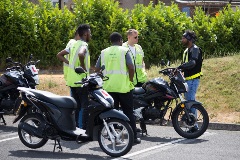Being young, free, and safe on the road, by Rideto
Ask any young motorcyclist why they ride, and ‘a sense of freedom’ often comes up. Sure, a car will take you most places, but there’s something about two wheels that’s more dynamic, less restricted – freer, in other words.

The Rules
Starting with your bike, the first requirement is that it’s legal for you to use. If you’re riding on a provisional licence aged 17 or over, you’re restricted to a 125cc machine, and it must have an MOT test pass, at least third-party insurance cover, and be taxed for the road. The MOT test checks most safety parts, like brakes, suspension, and tyres – but you can improve safety beyond the bare legal minimum, by fitting top-quality tyres which offer better performance and more grip in poor road conditions. RideTo.com has a guide to buying a bike here.Get the gear
When it comes to protective riding gear, the law says you must wear an approved motorcycle safety helmet when riding on the road – that’s the only compulsory piece of riding gear required by law. Switched-on riders will always wear the essentials though: tough boots, gloves, jacket, and trousers, which have been made to protect you in the event of a crash.
Once you’ve got those basics, you can add on more involved kit: a specific back protector, upgraded body armour for elbows, knees and shoulders, and even a rider airbag, which goes off like a car airbag in a crash, giving even more protection from impacts. RideTo.com has a great guide to kit for new riders here.
Focus
But perhaps the best protection comes from upgrading your mind. Riding a motorcycle on the road is probably one of the most involved pieces of dynamic coordination most people do – it’s no exaggeration to say it’s like flying a fast plane, skydiving, scuba diving, or some other extreme sport. You must merge a complete mental worldview of constantly changing surroundings, at speed, with the required physical movements of hands, feet and body, to manoeuvre through traffic, road hazards, pedestrians, poor weather. It’s a challenging task – but training can help massively (RideTo.com has all the info here).
From the very first steps in the CBT – Compulsory Basic Training – through the Module 1 and Module 2 sections of the practical riding test, the training that you do will kit your brain out with all the skills needed to stay safe on the road – and make the very most of those freedoms that only a motorbike can give you.
At IAM RoadSmart, we are passionate about empowering riders and drivers. As we see more young people passing their driving tests, we want them to be able to continue growing their on-road skillset. Check out our Young Drivers and Riders Campaign

